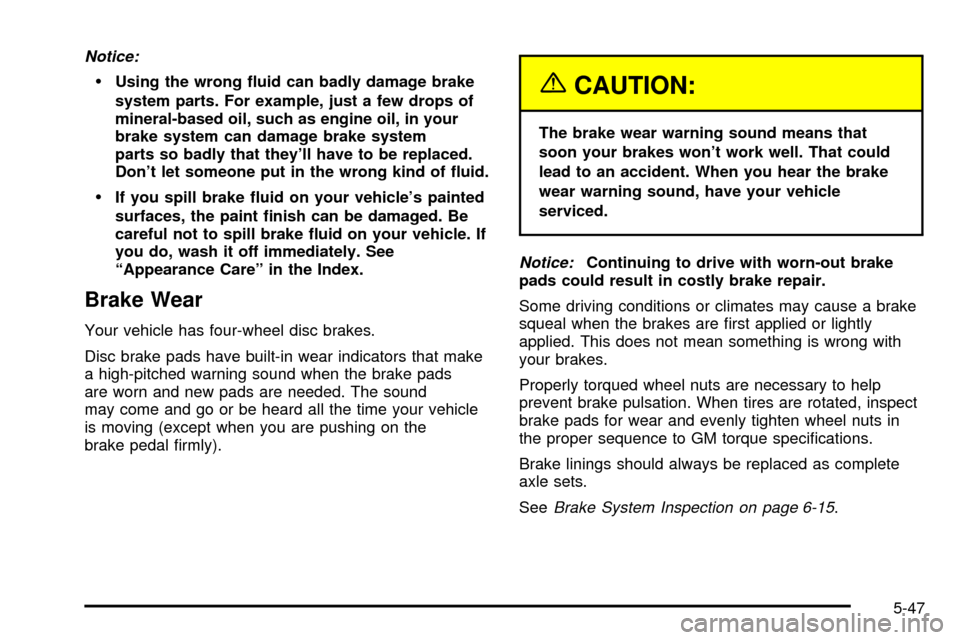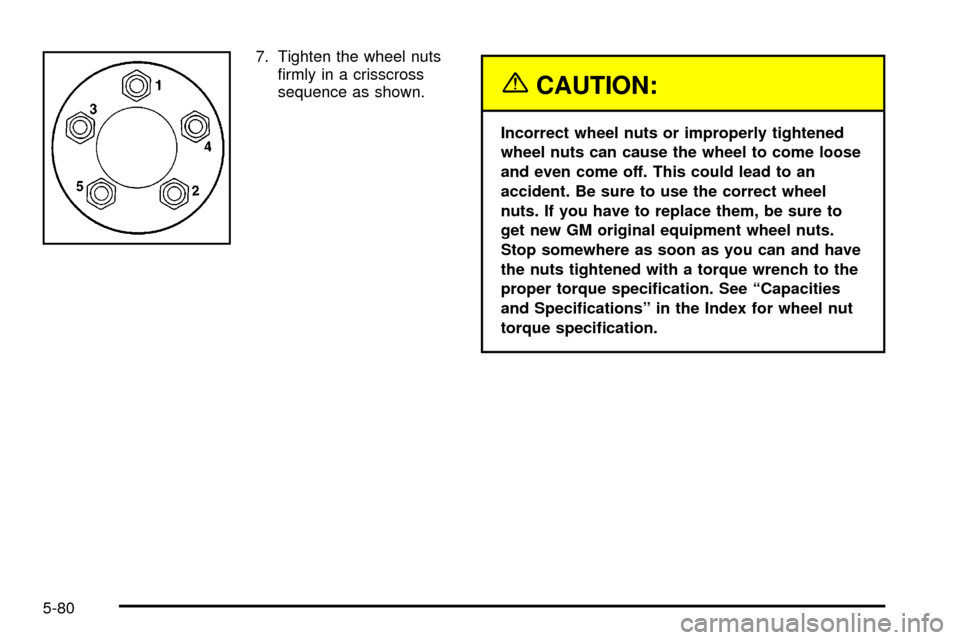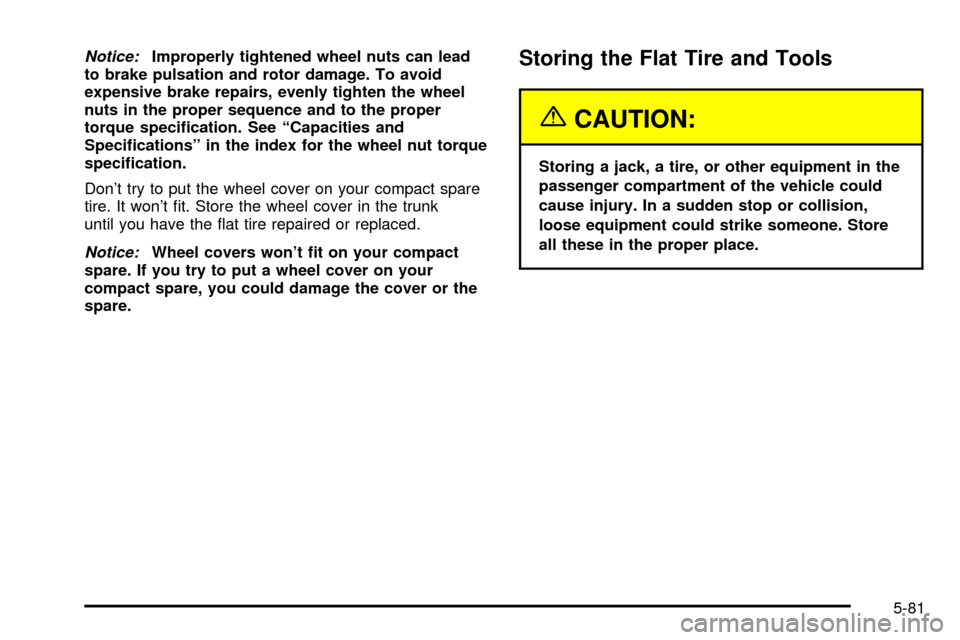2003 CHEVROLET IMPALA torque
[x] Cancel search: torquePage 98 of 408

Torque Lock
If you are parking on a hill and you don't shift your
transaxle into PARK (P) properly, the weight of
the vehicle may put too much force on the parking pawl
in the transaxle. You may ®nd it difficult to pull the
shift lever out of PARK (P). This is called ªtorque lock.º
To prevent torque lock, set the parking brake and
then shift into PARK (P) properly before you leave the
driver's seat. To ®nd out how, see
Shifting Into Park (P)
on page 2-27.
When you are ready to drive, move the shift lever out of
PARK (P)
beforeyou release the parking brake.
If torque lock does occur, you may need to have another
vehicle push yours a little uphill to take some of the
pressure from the parking pawl in the transaxle, so you
can pull the shift lever out of PARK (P).
Shifting Out of Park (P)
Your vehicle has an automatic transaxle shift lock
control system. You must fully apply your regular brakes
before you can shift from PARK (P) when the ignition
is in ON. See
Automatic Transaxle Operation on
page 2-23.
If you cannot shift out of PARK (P), ease pressure on
the shift lever by pushing it all the way into PARK (P)
while keeping the brake pedal pushed down. Release
the shift lever button if you have a console shift.
Then move the shift lever out of PARK (P), being sure
to press the shift lever button if you have a console shift.
If you ever hold the brake pedal down but still can't
shift out of PARK (P), try this:
1. Turn the ignition key to ACC.
2. Apply and hold the brake pedal down until the end
of Step 4.
3. Shift to NEUTRAL (N).
4. Start the engine and shift to the drive gear
you want.
5. Have the vehicle ®xed as soon as you can.
2-30
Page 303 of 408

Notice:
·Using the wrong ¯uid can badly damage brake
system parts. For example, just a few drops of
mineral-based oil, such as engine oil, in your
brake system can damage brake system
parts so badly that they'll have to be replaced.
Don't let someone put in the wrong kind of ¯uid.
·If you spill brake ¯uid on your vehicle's painted
surfaces, the paint ®nish can be damaged. Be
careful not to spill brake ¯uid on your vehicle. If
you do, wash it off immediately. See
ªAppearance Careº in the Index.
Brake Wear
Your vehicle has four-wheel disc brakes.
Disc brake pads have built-in wear indicators that make
a high-pitched warning sound when the brake pads
are worn and new pads are needed. The sound
may come and go or be heard all the time your vehicle
is moving (except when you are pushing on the
brake pedal ®rmly).
{CAUTION:
The brake wear warning sound means that
soon your brakes won't work well. That could
lead to an accident. When you hear the brake
wear warning sound, have your vehicle
serviced.
Notice:Continuing to drive with worn-out brake
pads could result in costly brake repair.
Some driving conditions or climates may cause a brake
squeal when the brakes are ®rst applied or lightly
applied. This does not mean something is wrong with
your brakes.
Properly torqued wheel nuts are necessary to help
prevent brake pulsation. When tires are rotated, inspect
brake pads for wear and evenly tighten wheel nuts in
the proper sequence to GM torque speci®cations.
Brake linings should always be replaced as complete
axle sets.
See
Brake System Inspection on page 6-15.
5-47
Page 321 of 408

Tire Inspection and Rotation
Tires should be rotated every 7,500 miles (12 500 km).
Any time you notice unusual wear, rotate your tires
as soon as possible and check wheel alignment. Also
check for damaged tires or wheels. See
When It Is Time
for New Tires on page 5-66andWheel Replacement
on page 5-69for more information.
The purpose of regular rotation is to achieve more
uniform wear for all tires on the vehicle. The ®rst rotation
is the most important. See ªPart A: Scheduled
Maintenance Services,º in Section 6, for scheduled
rotation intervals.
When rotating your tires, always use the correct rotation
pattern shown here.Don't include the compact spare tire in your tire rotation.
After the tires have been rotated, adjust the front and
rear in¯ation pressures as shown on the Tire-Loading
Information label.
Reset the Tire In¯ation Monitor System. See
Tire
Pressure Monitor System on page 5-63.
Make certain that all wheel nuts are properly tightened.
See ªWheel Nut Torqueº under
Capacities and
Speci®cations on page 5-103.
{CAUTION:
Rust or dirt on a wheel, or on the parts to
which it is fastened, can make wheel nuts
become loose after a time. The wheel could
come off and cause an accident. When you
change a wheel, remove any rust or dirt from
places where the wheel attaches to the vehicle.
In an emergency, you can use a cloth or a
paper towel to do this; but be sure to use a
scraper or wire brush later, if you need to, to
get all the rust or dirt off. See ªChanging a Flat
Tireº in the Index.
5-65
Page 336 of 408

7. Tighten the wheel nuts
®rmly in a crisscross
sequence as shown.
{CAUTION:
Incorrect wheel nuts or improperly tightened
wheel nuts can cause the wheel to come loose
and even come off. This could lead to an
accident. Be sure to use the correct wheel
nuts. If you have to replace them, be sure to
get new GM original equipment wheel nuts.
Stop somewhere as soon as you can and have
the nuts tightened with a torque wrench to the
proper torque speci®cation. See ªCapacities
and Speci®cationsº in the Index for wheel nut
torque speci®cation.
5-80
Page 337 of 408

Notice:Improperly tightened wheel nuts can lead
to brake pulsation and rotor damage. To avoid
expensive brake repairs, evenly tighten the wheel
nuts in the proper sequence and to the proper
torque speci®cation. See ªCapacities and
Speci®cationsº in the index for the wheel nut torque
speci®cation.
Don't try to put the wheel cover on your compact spare
tire. It won't ®t. Store the wheel cover in the trunk
until you have the ¯at tire repaired or replaced.
Notice:Wheel covers won't ®t on your compact
spare. If you try to put a wheel cover on your
compact spare, you could damage the cover or the
spare.
Storing the Flat Tire and Tools
{CAUTION:
Storing a jack, a tire, or other equipment in the
passenger compartment of the vehicle could
cause injury. In a sudden stop or collision,
loose equipment could strike someone. Store
all these in the proper place.
5-81
Page 360 of 408

Engine Speci®cations
Engine VIN Code Transmission Spark Pug Gap Firing OrderWheel Nut
Torque
3400 (LA1) V6 E 4T65E0.060 inches
(1.52 mm)1±2±3±4±5±6100 lb ft
140Y
3800 (L36) V6 K 4T65E0.060 inches
(1.52 mm)1±6±5±4±3±2100 lb ft
140Y
5-104
Page 406 of 408

T
Tachometer....................................................3-32
Taillamps.......................................................5-58
Turn Signal, Stoplamps and Sidemarker
Lamps....................................................5-58
TCS Warning Light..........................................3-35
Theft-Deterrent, Radio.....................................3-89
Theft-Deterrent Systems...................................2-16
Content Theft-Deterrent................................2-16
Passlock
ž...................................................2-17
Throttle System Inspection...............................6-15
Tilt Wheel........................................................ 3-7
Tire In¯ation Check.........................................6-10
TIRE MON (Tire In¯ation Monitor Reset)............2-46
Tire ...............................................................3-44
Low Message.............................................3-44
Tires.............................................................5-61
Buying New Tires........................................5-67
Chains.......................................................5-71
Changing a Flat Tire....................................5-72
Compact Spare Tire.....................................5-84
If a Tire Goes Flat.......................................5-71
In¯ation -- Tire Pressure...............................5-62
Inspection and Rotation................................5-65
Pressure Monitor System..............................5-63
Uniform Tire Quality Grading.........................5-68
Wheel Alignment and Tire Balance.................5-69
Wheel Replacement.....................................5-69
When It Is Time for New Tires......................5-66Tires (cont.)
To Use the Engine Coolant Heater....................2-22
Top Strap Anchor Location...............................1-42
Top Strap......................................................1-41
Torque Lock...................................................2-30
Total Weight on Your Vehicle's Tires..................4-37
Towing..........................................................4-31
Recreational Vehicle.....................................4-31
Towing a Trailer..........................................4-34
Your Vehicle...............................................4-31
Traction.........................................................3-41
Active Message...........................................3-41
Control System (TCS).................................... 4-9
Control System Warning Light.......................3-35
Service Traction System Warning Message.....3-41
Trailer Brakes.................................................4-37
Transaxle Operation, Automatic.........................2-23
Transaxle.......................................................5-24
Fluid, Automatic...........................................5-24
Transmission, Transaxle, Transfer Case Unit
Repair Manual............................................7-11
Transmitter Veri®cation...................................... 2-5
Transportation Options...................................... 7-8
Trip Computer................................................3-52
Trip Odometer................................................3-31
TRNKJAMB (Trunk Jamb)................................2-51
Trunk Ajar Warning Message............................3-45
Trunk Assist Handle........................................2-11
Trunk Lock....................................................2-11
Trunk............................................................2-10
14